Betamovie
| Betamovie | |
|---|---|
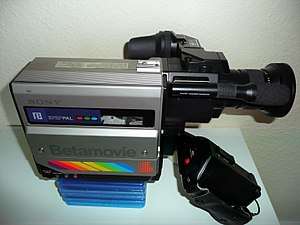 Sony Betamovie BMC-100P | |
| Introduced | 1983 |
| Encoding | NTSC, PAL |
| Recording media | Betamax cassette |
| Recording time on L-830 cassette: | |
| PAL | Up to 216 min. |
| NTSC |
BI: Up to 100 min. BII: Up to 200 min. BIII: Up to 300 min. |
| Write mechanism | Single head Helical scan |
| Playback | Not available |
| Intended usage | Home movies |
| Market | Consumer/Amateur |
| Developed by | Sony |
Betamovie is the brand name for a range of consumer grade camcorders developed by Sony for the Betamax format. By "camcorder" is understood a single unit comprising a video camera and a video recorder.
Betamovie records analog video on a standard Betamax cassette.
A range of models was manufactured for the PAL and NTSC formats. The first model, BMC-100P (PAL) and BMC-110 (NTSC) was released in 1983 making it the first commercial consumer grade camcorder.[1] While only standard beta units were available in PAL, several SuperBeta models were produced for the NTSC format.
Due to constructional limitations, the Betamovie has no playback function. It is only capable of recording. This limitation in combination with the decline of the Betamax format in the late 1980s, caused Sony to abandon the Betamovie - line just a few years after its initial release in favor of its newly developed Video8 format.
History
As far back as the 1960s, cameras were available for the reel-to-reel portable VTRs of that time. These cameras were similar in size and weight to the cine-cameras of the day. They generally used a single video camera tube. However, these systems were not in common use by ordinary consumers.
After the introduction of VHS and Betamax formats, in the mid 1970s, videocassette recorders (VCR) started gaining mass market traction. Thus, in 1982, 10% of UK households owned a VCR.[2] The first two-piece camera/VCR systems emerged around 1980. These units included a portable VCR, which the user would carry by a shoulder strap, and a separate camera, which was connected to the VCR by a special cable. These systems were cumbersome and heavy by today's standards. For example, the portable VCR, Sony SL-3000, from 1980 weighed around 9 kg. without the battery.[3] The accompanying camera (e.g. HVC-2000P) would weigh around 3 kg.[4] Thus, the complete setup could easily weigh in excess of 13 kg.
In order to be more appealing to the typical consumer wanting a practical device for recording home movies, a more compact and preferably one-piece device was needed. The world's first such device, the Betamovie BMC-100/110 was released in 1983 by Sony. Although the term was not in common use at that time, such a device would later become known as a camcorder, a single unit comprising a video camera and a video recorder. BMC-100/110 weighed just 2,5 kg. and was a much less cumbersome solution than its predecessors. The whole device could be supported on a user's shoulder. In order to achieve such weight and size reductions, several key components had to be miniaturized. One major requirement for a one-piece camcorder was miniaturizing the recording head drum. Sony's solution to this involved recording a non-standard video signal which would become standard only when played back on full-sized VCRs. A side effect of this was that Betamovie camcorders were record-only. Keeping in mind that instant playback is one of the main advantages of video cameras over cine-cameras, lack of a playback function presented a considerable limitation.[1]
In 1984, JVC presented it own version of a camcorder, the GR-C1, for the VHS format. Although it too had a miniature head drum, the JVC engineers developed a different solution to drum miniaturization which made it possible to record a standard video signal on the tape. Thereby, the user of a VHS camcorder could review footage on location and copy it to another VCR for editing. Sony was unable to duplicate the functionality of the VHS camcorders. This disadvantage was a primary reason for the early loss of market share by the Betamovie.
Despite this development, Sony held on to the Betamovie for a couple of years more releasing some more advanced models, especially for the NTSC market. However, in 1987, Sony finally abandoned the Betamovie in favor of its newly developed Video8 format.
Technical overview
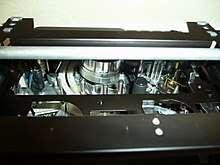
Betamovie uses the standard-size Betamax cassette, but the recording method is non-standard. The tape is wrapped 300° around a head drum nearly 45 mm. in diameter with a single dual-azimuth head to write the video tracks. Compared to the normal Betamax head drum of 75 mm, the Betamovie head drum spins at 2500 rpm rather than 1500 rpm. The fields on the tape are written at 120% the normal speed. As the head does not pass the tape at normal speed, the signal has to be electronically "time-compressed", before it is written.
When inserted into a standard Betamax VCR, the tape can be played back. However, the writing system employed in the Betamovie is not reversible. Therefore, playback within the camcorder is not feasible.
The early models have an optical viewfinder, which lets one see exactly what one is recording by looking directly through the lens, via a system of mirrors and prisms - similar to an SLR stills camera.[1] Some of the later models have an electronic viewfinder. They are still record-only devices, though.[5]
Also, the early models use a cathode ray tube as their image sensor and the BMC-100/110 has manual focus. Later models use CCD image sensors and feature autofocus.[6]
All Betamovies for the PAL format record in standard Betamax video mode. Some of the models for the NTSC format can record in the enhanced SuperBeta mode or even the Super Hi-Band Beta mode.[5]
Models
BMC-100 and BMC-110

Released in 1983. The first model and the world's first consumer grade camcorder.[1] BMC-100 is the PAL model and BMC-110 is the NTSC model.
The camera uses a cathode ray tube as its image sensor. It features 6X power zoom, manual focus, and an optical viewfinder. It requires 35 Lux to operate. The BMC-110 only records in BII.
BMC-200 and BMC-220
This camera features auto-focus. Apart from this, it is identical to the first model.
BMC-500 and BMC-550
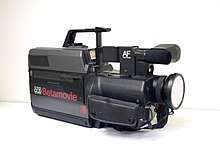
Released in 1985. A substantial redesign. This camera uses a CCD sensor and features time and date settings. BMC-500 is the last PAL Betamovie.
GSC-1
Released in 1985. NTSC model. This is an industrial/professional camcorder. It is similar to BMC-660. However, like BMC-1000, it features an electronic viewfinder.
BMC-660
Released in 1986. NTSC model. This camera records in SuperBeta mode, BII only.
BMC-1000
Released in 1987. NTSC model. An upgraded model. Features an electronic viewfinder and records in SuperBeta BI and Super Hi-Band Beta BI. It is still a record-only unit.
EDC-55 ED-Beta camcorder
EDC-55 became the final and most advanced iteration of camcorders for the Betamax format.
Actually, it does not belong to the Betamovie - lineup and is only mentioned in this article for the purpose of distinguishing it from the true Betamovie camcorders.
It is a semiprofessional/prosumer device that only records in the ED-Beta format, the final high-definition variant of the Betamax format. This camera produces over 550 lines of resolution, records in Hi-Fi stereo and features insert audio and video editing. Unlike the Betamovie camcorders, it can play back its own recordings. It was only released for the NTSC format.[5]
Accessories
AC Adapter/battery charger (AC-M100, AC-M110, BC-300)
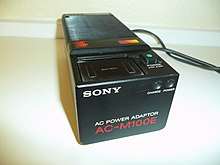
The AC-M100/110 is a combined AC Adapter and charger for a single NP-11 rechargeable battery. The output voltage to the camera is 9,6 V, 1 A. The battery is charged with 14 V, 1,2 A.
The principal difference between the M100 and M110 appears to be that the M100 can run on 110 - 240 V AC while the M110 can run on 100 - 240 V AC.
The BC-300 can charge three NP-11 batteries simultaneously.
Rechargeable battery (NP-11)
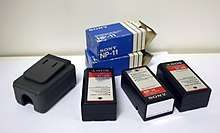
A Ni-Cad battery providing approximately one hour of continuous operation.
Carrying case (LC-710, LC-720, LC-760, LC-770)
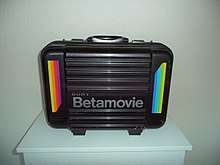
A hard shell carrying case.
LC-710 and LC-720 are designed for the BMC-100/110/200/220. The larger LC-710 can hold the camcorder, two NP-11 batteries and an AC-M100/110 adapter. The smaller LC-720 has no room for an AC-power adapter.
LC-760 is for the BMC-500/550/660. It can hold the camcorder, two NP-11 batteries and a BC-300 adapter.
LC-770 is for the GCS-1 and BMC-1000. It can hold the camcorder, two NP-11 batteries and a BC-300 adapter.
Jacket (LC-810, LC-850)
LC-810 is a flexible jacket for protecting the body of a BMC-100/110/200/220.
LC-850 is for BMC-500/550/660.
External microphone (SAD-100)
An externally mounted boom microphone.
Remote control (RM-81)
A wired remote control with a Record/Pause button.
Car adapter (DCC-2600)
A car adapter with cable for connecting to the cigarette lighter socket in a car.
See also
VHS-C A competing camcorder tape format.
Video8 A successor format to Betamovie.
References
- 1 2 3 4 "Total Rewind". www.totalrewind.org. Retrieved 2018-04-04.
- ↑ "Thatcher years in graphics". 2005-11-18. Retrieved 2018-04-06.
- ↑ "Betamax PALsite: SL-3000 : Specifications". www.palsite.com. Retrieved 2018-04-06.
- ↑ Wagner, Stephan. "Die Wagners Stephans Projekte". www.sps-wagner.de. Retrieved 2018-04-06.
- 1 2 3 "The Betamovies Page!". www.betainfoguide.net. Retrieved 2018-04-06.
- ↑ "Total Rewind". www.totalrewind.org. Retrieved 2018-04-06.